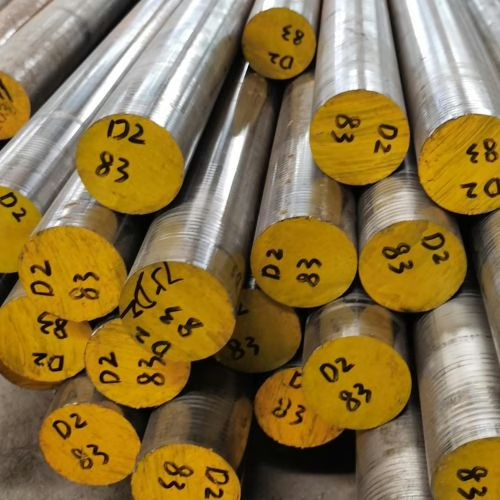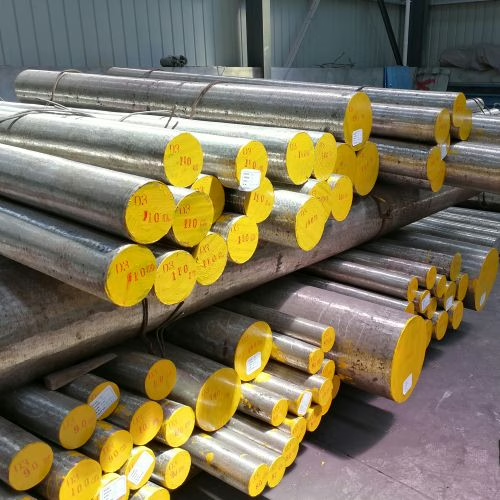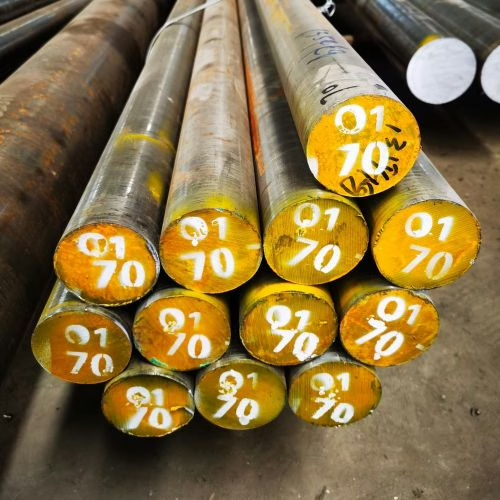
cold work tool steels catalog
Cold Work Tool Steels Catalog
Click on any product to view details.
What Is Cold-Work Tool Steel
Cold work tool steels are a critical class of alloy steels specifically designed for tooling operations where the working temperature is generally below 200°C (390°F), often at room temperature. This distinguishes them from hot work tool steels, which are used for applications involving higher temperatures (typically over 200°C and up to 800°C).
Classification
Cold work tool steels are systematically categorized, primarily by the AISI (American Iron and Steel Institute) system, into three main groups based on their quenching medium and composition:
- Oil-hardening types (O-series): These include grades like O1, O2, O6, and O7.
- Air-hardening, medium-alloy types (A-series): Examples are A2, A3, A4, A6, A7, A8, A9, and A10.
- High-carbon, high-chromium types (D-series): This group includes D2, D3, D4, D5, D6, and D7. The D-type steels were initially developed for high-speed cutting but found utility as cold-work die steels.
The International Standard EN ISO 4957 also classifies tool steels, with cold-work tool steels being divided into non-alloy and alloy categories.



Key Properties and Their Interplay
- High Hardness. This is a primary requirement, typically aimed at 60 HRC or higher, to provide resistance against plastic deformation under the high forces encountered in cold working operations. Higher hardness directly correlates with increased yield strength, preventing tools from deforming permanently. However, extremely high hardness can reduce machinability and grindability.
- High Wear Resistance. High wear resistance allows tool dimensions to remain stable for a long time, thereby extending tool service life. This performance is mainly achieved through a hard matrix (martensite) and the presence of undissolved hard carbide particles.
- Good Toughness. The ability to resist chipping, cracking, or breaking under impact loading. Hardness and toughness are often inversely proportional, so it is important to find a balance between the two. For impact work, high toughness is the primary consideration, while wear resistance is the secondary consideration.
- Dimensional Stability. When high precision is required for tools, the thermal stability of some tool steels becomes very important. In such cases, air-hardening steel is the material of choice.
- Machinability. Tools are generally supplied in a soft, annealed condition to facilitate shaping and machining before final hardening.
Composition and Microstructure
Cold work tool steels contain higher carbon contents (typically 0.60% to 2.50%) compared to many other steels, which is fundamental for achieving high hardness. They are also alloyed with various elements to enhance specific properties:
- Chromium (Cr): A moderate carbide former that contributes significantly to wear resistance, especially in high-carbon, high-chromium types (D-series). It also improves hardenability.
- Molybdenum (Mo) and Tungsten (W): While less prevalent than in hot work or high-speed steels, they can be added to improve hardenability and contribute to wear resistance by forming hard carbides.
- Vanadium (V): Forms very hard MC-type carbides (2300-3000 HV) that significantly boost abrasive wear resistance.
- Manganese (Mn) and Silicon (Si): Contribute to hardenability and, in the case of Si, can improve machinability and resistance to decarburization.
The microstructure of hardened cold-worked tool steels primarily consists of high-carbon tempered martensite and a dispersion of various carbides.
- Carbides: The type and distribution of carbides are crucial. Chromium-rich M7C3 carbides are typical in D-series steels, providing high wear resistance. The amount of these carbides increases with higher carbon and chromium content. Lower-alloyed grades like O1 have almost no carbides due to insufficient chromium content.
- Retained Austenite (RA): In high-carbon and high-alloy steels, some austenite may be retained after quenching. While austenite can absorb stress due to its ductility, retained austenite is undesirable as it reduces hardness and can cause dimensional instability by transforming to brittle martensite under stress, leading to cracking or chipping. Control of RA is achieved through composition, hardening temperature, and tempering temperature. Subzero treatments (cryogenic treatments) can also be applied to convert retained austenite into martensite for improved hardness, dimensional stability, and fracture toughness.
Heat Treatment
The desired properties of cold work tool steels are primarily achieved through precise heat treatment procedures:
- Annealing. The purpose of annealing is to reduce the hardness of tool steel, making it easier to process. The process involves heating tool steel to a high temperature and maintaining it for a period of time, followed by slow cooling to achieve uniformity of structure and formation of a softened microstructure, usually accompanied by carbide spheroidization, to obtain optimal machining performance.
- Quenching. This process involves heating tool steel above its critical temperature range to form austenite, then rapidly cooling it to convert it into hard martensite. Cold work steels are distinguished by their quenching media: water (W-series), oil (O-series), or air (A-series, D-series). Air quenching is preferred for minimal distortion and highest safety against cracking. Water quenching causes severe thermal shock and distortion. These vary significantly by grade, e.g., O1 at ~790-815°C (1450-1500°F), A2 at ~980°C (1800°F), D2 at ~1010°C (1850°F), and W1 at ~800°C (1475°F).
- Tempering. After quenching, the hard and brittle martensite is reheated to an intermediate temperature (tempering) to soften it slightly, relieve internal stresses, and improve toughness. Cold work tool steels are typically tempered at low temperatures (around 150-300°C / 300-570°F) to achieve high hardness, usually around 60 HRC.
Applications
Cold work tool steels are extensively used in diverse manufacturing operations due to their ability to withstand high pressure, impact, and abrasion at or near room temperature. Typical applications include:
- Forming: Bending dies, coining dies, cold heading dies (e.g., W1, W2), cold extrusion dies, drawing dies (for wire, bars, deep drawing).
- Shearing and Cutting: Blanking dies, shear blades (hot and cold), knives (cold work).
- Punches: General punches, piercing punches, and dies.
- Miscellaneous: Wear-resistant machine tool components, woodworking tools, measuring tools, and fasteners.
- Shock-resistant applications: S-series steels (e.g., S1, S5, S7) are used for tools requiring high toughness, such as chisels, powder pressing molds, and shear-cutting thick plates.
FAQ
Cold work tool steels are a class of tool steels used for tooling operations at temperatures typically below 200°C (390°F), generally at room temperature. They are designed to offer high hardness, mechanical strength, and wear resistance, which are achieved through specific heat treatments and the presence of coarse carbides in their microstructure.
There isn’t a single “best” steel, as the optimal choice depends on the specific application’s requirements, balancing wear resistance and toughness. Common types include high-carbon, high-chromium steels (D-series), air-hardening steels (A-series), oil-hardening steels (O-series), and shock-resisting steels (S-series). High-speed steels (HSS) and powder metallurgy (PM) tool steels also offer excellent wear resistance for cold work.
The primary difference lies in their operating temperature ranges and optimized properties. Cold work tool steels are for applications below ~200-260°C (390-500°F) and prioritize high hardness and wear resistance. Hot work tool steels are for applications above this temperature range (up to 800°C or 1472°F) and are characterized by hot strength, resistance to softening at elevated temperatures (red hardness), and toughness, often with lower hardness compared to cold work steels.
Cold working, also known as strain hardening or work hardening, is the plastic deformation of a metal at temperatures below its recrystallization temperature, typically at or near room temperature. This process causes distortions in the internal structure of the metal.
The primary purposes of cold working steel include increasing strength, hardness, and dimensional or microstructural stability, as well as improving wear resistance. It also produces a smooth, clean surface finish, achieves greater dimensional accuracy, and can improve machinability by causing chips to break more easily.
Yes, cold working directly increases the hardness of steel. As plastic deformation builds up, the internal structure distorts, making further deformation more difficult and increasing both the strength and hardness of the metal.
“Cold steel” typically refers to steel that has undergone “cold working” (e.g., cold rolling or cold drawing) at room temperature, which increases its hardness, strength, and provides a better surface finish and dimensional control. “Regular steel” can refer to hot-rolled steel, which is processed at high temperatures, usually resulting in a rougher surface and lower hardness but higher ductility initially.
No, cold working itself does not decrease grain size; it distorts and elongates the existing grains. Grain refinement (making grains smaller) occurs during a subsequent heat treatment process called annealing, which promotes recrystallization of new, finer grains after the cold work.
Cold work percentage is typically calculated as the percentage reduction in the material’s cross-sectional area or thickness. For example, a 70% thickness reduction means the material’s thickness has been reduced by 70% through cold working.
Cold working is widely used to improve a steel’s mechanical properties (like strength and hardness), achieve precise dimensions and smooth surface finishes, and enhance machinability. It is applied in processes like cold rolling of sheets and strips, cold drawing of bars and wire, cold heading, coining, and extrusion, particularly for automotive, aerospace, and general engineering components.
Cold working is performed at temperatures below the metal’s recrystallization temperature, typically at or near room temperature. Although the process itself can generate some heat due to deformation, the material generally starts at room temperature.
Cold working enhances mechanical properties like strength, hardness, and yield strength, improves surface finish and dimensional accuracy, and allows for better reproducibility and interchangeability of parts. It also minimizes contamination problems and can impart desirable directional properties.
Cold working is plastic deformation at temperatures where annealing doesn’t rapidly occur, leading to strain hardening, increased strength, and decreased ductility. Annealing is a heat treatment that softens metallic materials, relieves internal stresses, and restores ductility by heating and then cooling at an appropriate rate, often reversing the effects of cold working.
“Hot work” and “cold work” typically refer to the temperature at which a tool steel is designed to operate. Hot work tool steels are for high-temperature applications (above ~200°C), requiring hot hardness and resistance to softening at elevated temperatures. Cold work tool steels are for room temperature applications, focusing on high hardness, wear resistance, and toughness. Separately, hot working and cold working are also metal forming processes that occur above and below the recrystallization temperature, respectively.
No, cold working decreases a metal’s ductility and increases its hardness and strength. To restore ductility for further deformation, intermediate annealing is often required.
Cold working stainless steel involves deforming it at room temperature to increase its strength, hardness, and sometimes induce martensite formation (especially in austenitic types), while decreasing its elongation. It generally requires higher forces than cold-working carbon steels due to stainless steel’s higher work-hardening rates.
Yes, Type 316 is an austenitic stainless steel that can be cold worked81373. Austenitic stainless steels, including 316, are commonly subjected to cold working processes such as cold heading296482. Cold rolling, even at sub-zero temperatures, can be used to induce martensite and increase its work hardening rate373.
Hot work tool steels are a category of tool steels specifically engineered for cutting or forming operations where the workpiece or tool itself will reach elevated temperatures, typically above 200°C. Their primary characteristic is “hot hardness,” meaning they retain their strength and hardness at high temperatures. They also exhibit good toughness and wear resistance under hot conditions. Common examples include the AISI H-series steels.
Stainless steel refers to a family of alloy steels characterized by high corrosion resistance due to a minimum of 10.5% chromium content90…. “Cold steel” is not a type of steel, but usually refers to “cold-finished steel,” which describes carbon or alloy steels that have been processed at room temperature (cold working, turning, grinding) to achieve specific characteristics like improved dimensional accuracy, smoother surface finish, and increased strength and hardness through work hardening20…. So, stainless steel is a material composition, while “cold steel” refers to a processing method applied to various steel compositions.
Get Your Competitive Edge with Premium Tool Steel
Leverage our 20+ years of forging expertise. We don’t just sell steel; we provide tailored solutions. Contact our specialists for detailed information and a highly competitive quote.
Expert Guidance Market-Leading Prices
